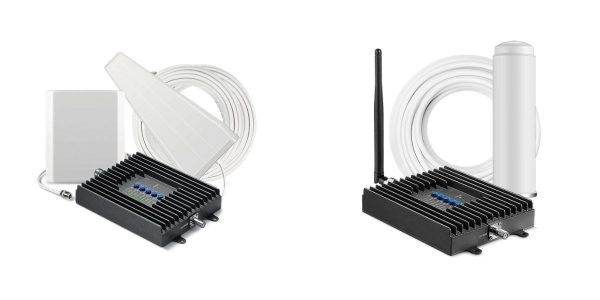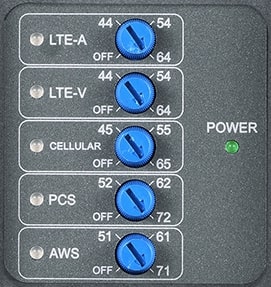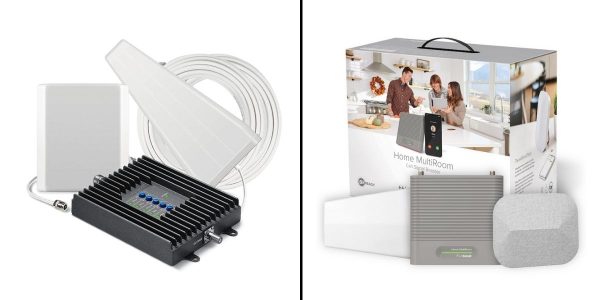Constantly battling with weak reception and being tormented by mobile network not available errors when you’re indoors can be quite frustrating. These can lead to dropped calls, unsent and unreceived messages, and online content that just won’t load. Generally, the more building materials around you and the farther you are to cell towers, the weaker your reception is. Given this, how do you boost your mobile coverage?
SureCall Fusion4Home, one of the best cell phone reception boosters in the market, claims to be the immediate fix to your signal woes. It promises to improve cell reception for calls, texts, and 4G LTE and 5G services, regardless of your carrier network. In this guide, we’re going to find out if SureCall Fusion4Home does exactly what it claims to do.
Also Read: How to Check Network Coverage for Verizon, Sprint, AT&T?
In This Article
- Does SureCall Fusion4Home Really Work?
- How Does SureCall Fusion4Home Improve Your Cell Phone Reception?
- Choosing the Right SureCall Fusion4Home Antennas
- SureCall Fusion4Home Pricing
- Setting Up SureCall Fusion4Home
- Coverage and Performance
- SureCall vs. weBoost: Which Is Better?
- Verdict
Does SureCall Fusion4Home Really Work?
Short answer: yes, SureCall Fusion4Home does the job. If you have a very weak reception in your home and in your office, installing SureCall Fusion4Home will certainly help boost your signal strength.
However, it’s not guaranteed to work in all situations. For instance, if your area doesn’t have any detectable reception, to begin with, then SureCall Fusion4Home — or any cell phone signal booster for that matter — won’t work. Thus, you have to make sure that there’s a strong enough signal outside your home for the booster to work.
Check Out the SureCall Website
How Does SureCall Fusion4Home Improve Your Cell Phone Reception?

Boosting your cell phone reception sounds like a complicated process, but it’s actually pretty simple, thanks to modern technology. To boost the signal coming from a cell tower, SureCall Fusion4Home makes use of four key tools: an outdoor antenna, a central booster, a cable, and an indoor antenna.
It all starts with the outdoor antenna, which collects signals from the cell tower that’s nearest to your house. The outdoor antenna then uses the coax cable to transmit the signal to the central booster. The booster’s job is to amplify the collected signal and send it through the indoor antenna, which then rebroadcasts the signal to the mobile devices within range. When you’re sending something out through your phone, like a call or a text, the process works in reverse. The indoor antenna amplifies the signal in your home and sends it back to the cell tower.
Choosing the Right SureCall Fusion4Home Antennas

When you buy a SureCall Fusion4Home kit, it’s important to choose the right indoor and outdoor antennas so that you can get the most out of your booster. There are two types of indoor antennas you can choose from: the whip and the panel. The whip is the slender, black, plastic antenna that you connect to the booster itself. This is best if you’re looking to boost the signal in one room only. On the other hand, the panel, which is the white, rectangular, plastic antenna that you mount to a wall, is best for larger open areas.
There are also two types of outdoor antennas for your SureCall Fusion4Home kit: Yagi and Omni. The Yagi is a triangular directional antenna and covers up to 3,000 square feet, or roughly two to four rooms. To install a Yagi antenna, you have to mount it on a pole or pipe, which isn’t provided in the installation kit. Plus, you need to place it as high up on the roofline as you possibly can and point it towards the direction of the nearest cell tower. You’ll want to go for this method if you only have one cell tower within a 30-mile radius.
On the other hand, the Omni is a cylindrical antenna and only covers up to 2,000 square feet. That said, it’s easier to install than the Yagi. It is Omni-directional, hence the cylindrical shape, and sends or receives signals in a 360-degree radius. That means there are fewer restrictions when it comes to where you should mount it. The Yagi antenna is best for those who live in an area with multiple cell towers.
SureCall Fusion4Home Pricing
The Price of a SureCall Fusion4Home booster depends on the types of outside and indoor antennas you get. Check out the table below for the current Fusion4Home prices on Amazon:
| Outdoor Antenna | Indoor Antenna | Price | Next Step |
|---|---|---|---|
|
Yagi
|
Whip | $399.99 | |
| Yagi | Panel | $499.99 | |
| Omni | Whip | $290 | |
| Omni | Panel | $400 | |
These prices are still cheaper than that of most cell phone reception boosters. For comparison, weBoost Multiroom, one of its top competitors, costs $549.99 on Amazon. WilsonPro 70 Plus, another one of the best cell phone reception boosters in the market, costs a whopping $1,199.99. That said, WilsonPro’s signal-boosting capacity is one of the strongest out there, and it provides a more expansive coverage area than other boosters.
Setting Up SureCall Fusion4Home
Setting up SureCall Fusion4Home isn’t that difficult. But you will need a bit of patience throughout the process, especially if this is your first time setting up a cell phone signal booster.
1. Identify the Area with the Strongest Signal
The first step of the setup process is to identify the area that gives you the best signal, which is easy enough to do with your phone; just put your phone on Field Test Mode, and you’ll be able to see the level of decibels (dB) your phone is receiving. According to SureCall, the location of the outdoor antenna should be receiving at least -100 dB. For the best performance, the signal should be between -70 dB and -90 dB. Note that decibels are measured in negatives, which means the closer the reading is to zero, the stronger the cell reception. If your signal is at -120 dB, that means you have no service.
2. Install the Outdoor Antenna
After you’ve determined the area with the best signal, it’s time to install the outdoor antenna at that spot. When doing so, it’s important to keep in mind the distance between the outdoor antenna and the indoor antenna. SureCall recommends a distance of at least 25 vertical feet since vertical separation gives you a better signal than horizontal separation. But if vertical separation isn’t totally possible, you’ll have to increase the distance to about 40 to 60 feet.
3. Install the Indoor Antenna and the Booster
Once the outdoor antenna is in place, the next thing to do is to install the indoor antenna and the booster. There are several things to consider when choosing the best installation spot for these two. First, as we already mentioned, the distance between the inside and outdoor antennas should be at least 25 vertical feet. Second, there should of course be a working power outlet where you can plug in the booster. Third, there shouldn’t be a lot of building materials obstructing the signal from the indoor antenna and your cell phone. Lastly, and perhaps most importantly, there shouldn’t be an open fire near the booster, and the temperature in the room shouldn’t be either too cold or too hot.
4. Turn on the Booster
Next, you’ll need to turn the booster on. To do that, you first need to connect it to the AC power cord that comes with the kit. Then, plug it into a 110V outlet, and turn the power switch on. You’ll know it’s working when the Power LED lights up.
5. If Necessary, Configure Gain Settings

Configuring gain settings is a bit trickier than the previous steps, but it’s still manageable. And the good news is that you don’t have to do this step if your booster’s already working fine when you turn it on. To determine if you need to do some configuring, make a call in the same room as the indoor antenna. If you’re able to do so without your call getting dropped, then that means you’re receiving a boosted signal and you’re good to go.
Otherwise, you might have to adjust some dials on the booster. If you see a flashing red or flashing red-yellow light, you should either adjust the location of the outdoor antenna or increase the distance between the inside and outdoor antennas, depending on the type of outdoor antenna you have. Also, make sure that the dials are always at the maximum level. However, if the light continues to flash red or red-yellow, then you should lower the gain setting in increments of 5 dB until the light turns off or starts flashing yellow.
Check out the user manual for more details on how to set up a SureCall Fusion4Home signal booster.
Coverage and Performance

SureCall Fusion4Home covers up to 3,000 square feet if you get the Yagi outdoor antenna and up to 2,000 square feet if you get the Omni antenna. That’s a decent enough coverage area considering the price point. However, the boosted cell phone reception won’t always cover the 2,000 or 3,000 square feet. The strength of the boosted indoor signal still mostly depends on the signal that the outdoor antenna is receiving.
In terms of performance, SureCall Fusion4Home gives your cell phone reception a good boost. With this installed in your home, you can expect that the amount of dropped calls indoors will lessen. Plus, your text messages will be delivered more easily, data-reliant apps will load much faster, and your device’s battery life will last longer. That said, it isn’t really the best available option. Other cell phone reception boosters cover anywhere between 5,000 to 25,000 square feet. The only catch is that these other brands cost more.
SureCall vs. weBoost: Which Is Better?

SureCall has a lot of competitors, but perhaps its strongest and most popular rival is the weBoost, which has been an industry leader for almost two decades now. weBoost has a similar product to SureCall Fusion4Home — the weBoost Home MultiRoom. So, which one is better between the two? The answer mostly depends on your budget and your needs.
Priced at $549.99, weBoost Home MultiRoom is the more expensive option of the two, by $50. That said, it does cover up to 5,000 square feet, whereas SureCall doesn’t guarantee any coverage beyond 3,000 square feet.
Both brands are FCC-approved and are compatible with all North American carriers, including AT&T, Verizon, T-Mobile, and Sprint. They’re also both compatible with 5G devices, so boosting your data speed won’t be an issue.
In terms of design, weBoost Home MultiRoom definitely bags the prize. Its indoor antenna has a fabric covering that can easily blend with your home’s furniture. Plus, its central booster arguably looks sleeker and more stylish than Fusion4Home’s more industrial-looking booster.
Thus, if aesthetics and coverage are important factors for you, then weBoost Home MultiRoom might be your best bet. But if you’re looking for a cheaper phone reception booster for a small- to mid-sized home or office, then you should go for SureCall Fusion4Home.
Verdict
SureCall Fusion4Home is a viable option if you’re looking to boost the reception in a 2,000- to 3,000-square foot area without breaking the bank. The setup process is simple enough for the most part, except if you have to configure the gain settings. Plus, it does a satisfactory job of sending texts, getting calls through, and loading online content. All in all, if you have a small- to medium-sized home, SureCall Fusion4Home can be the signal booster for you.
Have you tried boosting your cell phone reception with SureCall Fusion4Home? If you have, feel free to share your experience in the comments!
